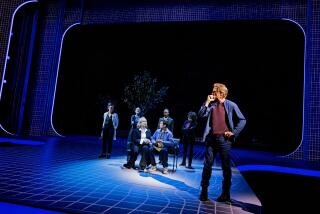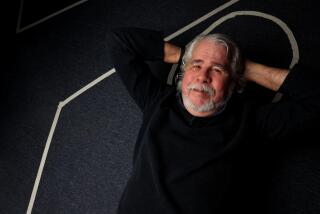Shanley, assured
NEW YORK — John Patrick Shanley is rarely at a loss for high-quality words.
His script for 1987’s “Moonstruck” won the original screenplay Oscar, 2002’s television movie “Live From Baghdad” brought him a shared Emmy nomination, and his 2004 play “Doubt: A Parable” captured the Tony and the Pulitzer for drama.
Shanley’s tougher test has been crafting equally compelling visuals to accompany his prose.
The 58-year-old Shanley struggled with that transformation the last time he stepped behind the cameras -- almost two decades ago, with the contentious production of 1990’s “Joe Versus the Volcano.” So when he sat down to adapt “Doubt,” opening Dec. 12, Shanley looked for any number of ways to fill his highly contained four-character play with new energy and nuance -- a quest that not only led him back to his childhood, from which the play sprung, but also to rely on “every trick” in the book to keep audiences engaged.
“When plays are turned into films, people stop listening,” Shanley says of the disconnect in dialogue-heavy movies. “This was the hardest script I ever wrote.”
Theatergoers will remember “Doubt’s” narrative, which unfolds in 1964. Sister Aloysius Beauvier (played in the film by Meryl Streep), the exacting, traditionalist principal of a New York parochial school, believes the charismatic, progressive priest Father Brendan Flynn (Philip Seymour Hoffman) may have an inappropriate relationship with Donald, one of the school’s young boys.
As part of her campaign to drive out the priest, Sister Aloysius attempts to enlist the boy’s reluctant mother (Viola Davis) and the skeptical young nun Sister James (Amy Adams).
The priest insists Sister Aloysius is on a witch hunt, but Shanley is less interested in who is -- or is not -- in the right. Instead, his play, like the movie, is focused on larger themes of confrontation and judgment, how meaningful deliberation has been trumped by argumentative, know-it-all declarations.
“Doubt,” in other words, is not so much about Catholic Church abuse scandals as it is about Nancy Grace and all of her judge-jury-executioner talk-show brethren. “We’ve got to learn to live with a full measure of uncertainty,” Shanley writes in the preface to his play. “There is no last word.”
Uncertainty is not inherently dramatic, of course, so Shanley looked for all possible opportunities to make his film kinetic. “Everything,” Shanley says, “has to mean something.”
The play opens with Father Flynn preaching about faith. The same sermon launches the movie, yet we simultaneously see Sister Aloysius patrolling the nave like a bomb-sniffing dog. “We have to introduce her so that we know it’s a duel,” Shanley says over lunch, “and give equal weight to her existence -- to her as a character.”
While Shanley added some characters to the movie, the most tangible addition is the Bronx, where Shanley grew up. Shanley filmed in a number of neighborhoods and locations from his youth, including an establishing shot (the local bishop wouldn’t grant permission to film inside) of St. Anthony’s school, where Shanley was kicked out of its hot lunch program for food fights.
“This is very personal. This is my childhood,” Shanley says, adding that the sexual abuse accusation in the story is not autobiographical. “I remember every single person from my eighth-grade class,” Shanley says. (Sister James was based on Shanley’s second-grade teacher, Sister Margaret McEntee, who was a technical advisor on the film.) Michael Roukis was cast as the rebellious student William London because he reminded Shanley of classmate Tommy Diehl.
Shanley’s special connection to the story also explains why he wanted to direct “Doubt” after suffering through the making of “Joe Versus the Volcano” 18 years earlier. He wasn’t in any hurry to return to Hollywood and has directed any number of his own plays for the stage. Producer Scott Rudin says Shanley never plotted his career with the intention of becoming a film director. “He goes after what interests him,” Rudin says.
“That shoot was a fight,” Shanley says of “Volcano,” the romance that starred Tom Hanks and Meg Ryan. “I threatened to quit two or three times. I was in constant war with Warner Bros. I took a lot of [grief] over ‘Joe’ from certain quarters. And I wanted to show that I actually could put something up on screen. I just knew that ‘Doubt’ was a challenge that I couldn’t pass up.”
To do so, however, meant leaving part of the play behind. The prize-winning staging starred Cherry Jones as Sister Aloysius, Brian F. O’Byrne as Father Flynn, Adriane Lenox as Mrs. Muller and Heather Goldenhersh as Sister James. Shanley toyed with recasting Lenox as the boy’s mother but realized it would be better to start fresh with all new actors.
“He was interested in reinvestigating the material,” says Rudin, a producer of both the play and the movie. “I can’t take credit for Doug Hughes’ work,” Shanley says of the play’s director. “He directed a play and he directed them brilliantly.” To make the movie with the same cast, Shanley says, “was something weird.”
Shanley looked for telling details and visual cues to underscore how the competing characters see the world. Sister Aloysius, who rejects ballpoint pens and sugar, is trying to keep the future at bay. Sister James is more open to new ideas. “Sister Aloysius definitely believes in the existence of evil,” Shanley says. “And Sister James does not.”
If the movie is to succeed as well as the play, Shanley knows audiences must leave the theater unsure about which character -- if any -- is the most virtuous. So as he added new scenes, he labored to make sure they didn’t tip the scales. Father Flynn is seen avoiding Donald in the hallway (a scene mentioned but not shown in the play) and then helping pick up Donald’s books and comforting him when a bully runs into him (which isn’t in the play at all). “You do see that the accusation is affecting his ability to function,” Shanley says of the pressure on the priest, “but you also see that his sense of compassion is stronger than his sense of fear.”
Those scenes illustrate how Shanley has made his movie of “Doubt” less of a point-counterpoint debate and, as Rudin says, “a much, much more nuanced” drama about the nature of character and appearances.
“Really, what ‘Doubt’ is about is change, and the cost of change,” Shanley says. “At the end of the story, everybody has paid a price for change. . . . This isn’t about whether this guy is guilty or innocent. We’re a verdict society. But what I find satisfying is when people start questioning themselves.”
--
More to Read
Only good movies
Get the Indie Focus newsletter, Mark Olsen's weekly guide to the world of cinema.
You may occasionally receive promotional content from the Los Angeles Times.











